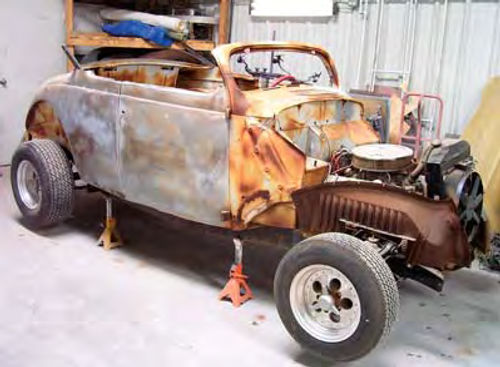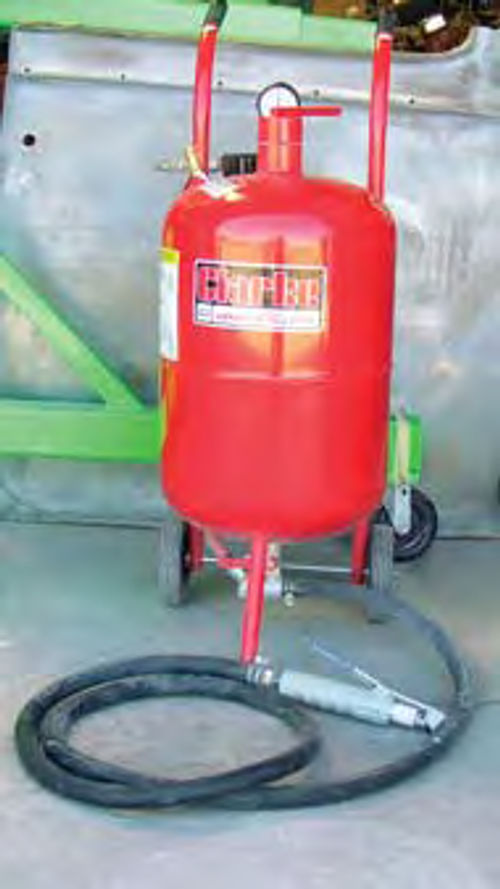Soda Blasting Metal & Fiberglass
Soda Does the Job and Won’t Damage Your Project Pieces. And Now, Compact Blasting Units are Available.
I FIRST REPORTED ON the process of soda blasting to remove old paint from vintage rides in July 2005. Back then this was a cutting edge and very environmentally friendly way to remove old paint. The problem was that the process required large scale equipment that was best suited to a commercial operation. The big truck came to the shop, blasted away at whatever needed blasting, and left with your hard-earned cash in the glove box.
Since then things have changed. Just like everything else, as time has passed the process of soda blasting has been refined and the equipment to perform the paint removal operation has been scaled down. There has been so much progress in this area that today there’s a unit that will hold two 50-pound bags of soda, can be wheeled out of the shop when needed, and operates on as little as 80 psi at the inlet. That’s pretty much any 60-gallon, three- to five-horsepower air compressor capable of cranking out at least 7 cfm at 80 psi.
Some Blasting Background
But then three years is a long time between introductions to soda blasting, and in addition to the changes in the equipment, there may be some things you have forgotten about the process. So I’ll start with where we came from and why soda is such a great improvement over methods of paint removal we’ve used previously.
In the beginning we used sand. That media hasn’t gone away, but we rarely use this method of paint removal on vintage rides anymore. Sand had a tendency to pit metal, warp panels, and exposes the user to airborne silica particles. Soda does none of these. It doesn’t harm the metal in any way, nor does it pose a health threat to the user.
Next came media blasting. I use the term “media” as all-encompassing because within that realm there was everything from pecan shells to glass beads to plastic pellets. It was definitely safer to use than sand from a personal standpoint, but you still had to deal with residues as well as the risk of contaminating the metal by touching it once it had been blasted clean.
Contaminating the metal? Yes, blasting the metal clean of old paint, whether using sand or some media other than soda, leaves the pores of the metal open and exposed.
The simple act of touching the cleaned metal with your bare hands can leave behind oils from your skin. That oil can get into the open pores of the metal and unless the metal is then thoroughly cleaned using a degreasing agent, that oil can keep any coating applied over the bare metal from sticking.
I’ve seen sand- and media-blasted metal panels that had begun to surface rust and within that surface rust I could see the actual fingerprints left from some unsuspecting helper who had handled the panels. The cops couldn’t ask for better fingerprints.
That’s one of the areas where the soda blasting process really shines.
Since soda is a natural rust inhibitor, it leaves behind a rust-inhibiting residue on the surface being blasted. That means immediate surface rust isn’t a paramount problem. You can even touch the metal with your bare skin and not create a contamination problem.
You also can leave a soda blasted surface bare and exposed for several days without worrying about surface rust forming. That translates into months if you happen to live next door to me in this hot dry part of Texas.
At this writing, the car I used as a guinea pig to test this soda blasting unit has been sitting bare and exposed for more than three months. I’ve yet to see any surface rust forming. I suspect if you live in Florida you are looking at days rather than months, but you get the idea.
So what is this soda stuff and how does it work? Tossing out the technical jargon, soda blasting is a method of coating removal using Sodium Bicarbonate, which is nothing more than baking soda. You could brush your teeth or bake biscuits with this stuff and not have to worry about any safety aspects from having used it. OK, it’s safe enough to eat, but I wouldn’t. It is specially formulated for blasting away old paint and would probably have a “sand in your sandwich” aspect to it. What you will learn as you use this product is that it does indeed taste like soda.
Is it possible for soda blasting to harm the surface being cleaned? I suppose anything can harm anything given the right circumstances.
However, as I mentioned previously, when used properly soda blasting will not cause damage to, or warp metal panels. That also goes for fiberglass and some plastics. Soda blasting will take off old paint, body filler, undercoats and light rust without damaging the surface. That’s because soda is an extremely soft media, rated at 2.4 on the Mohs scale of mineral hardness. That’s roughly equivalent to blackboard chalk.
Soda Provides Explosive Action
So how is it possible for such a soft material to remove old paint and body filler? The soda particles actually explode upon contact with the surface being cleaned. It is this explosive action that blasts away the old paint, fillers and light rust. The trick is that when the soda particle explodes that explosion doesn’t generate enough heat to cause the metal to warp. One company actually made a claim about removing the labeling from a cola can without damaging the can. You got it; I had to put that one to the test. Here is the result (Photo 1). It is hard to believe you can soda blast something as thin as an aluminum can and not destroy it.
As I’ve already mentioned, soda leaves behind a rust-inhibiting residue on the surface being blasted and that residue gives you a window of time between blasting and priming. That can be a lifesaver should you need to blast today and prime next week.
When you are ready to prime the surface, it can be quickly prepped by giving it a thorough washing with a high pressure washer to remove the residue. Once the surface is clean of the soda residue it can be dried and primed.
Forget trying to degrease or solvent wash anything blasted with soda before you wash it with water. These products will not remove the soda residue and may even cause the primers applied over the surface to not stick. Water is the only thing that will remove the soda residue.
Soda Disposal
Can I sweep up the used soda and reuse it? No. As mentioned above, soda particles explode upon contact with the surface being cleaned and, therefore, cannot be reused.
What can you do with the residue? That’s another point in soda’s favor. As I’ve said, soda is actually edible, with a Ph of 8.4. That makes it safe for you and the environment. When you are finished with the blasting, just wash the driveway and you are done. The soda will dissolve and the old paint particles will clump into a removable pile that can be swept up and disposed of properly. What’s properly? For me, that means bagged and into the dumpster. (As always, you should check with your local authorities when trying a new product to see if they have any special requirements.)
What about soda collecting in the corners and hard-to-reach places on your project? That’s not a problem either. Since soda is water soluble, the high-pressure wash will remove all traces of soda from the cracks and crevices of your ride. There is nothing left to blow out of the seams and land in your fresh paint job.
Is safety equipment necessary? You bet. My preference is an old painter’s suit that can be tossed after use, rubber gloves, eye protection, ear protection, and a respirator. Soda may be safe for you and the dog to eat but it isn’t a very good idea to breathe the stuff or track it into your house.

Blasting Fiberglass

Is soda safe to use on my vintage Vette? Soda is probably the best product on the market for cleaning the aging paint off of the Corvette. It won’t harm the fiberglass, or SMC if you happen to own a later model and, of course, you don’t have to worry about surface rust forming here.
You don’t even have to remove the glass, chrome or the stainless steel trim. Soda will not harm any of these. Aluminum is another matter. Soda will dull aluminum trim and once dulled you will never be able to bring back the shine. Check the back glass reveal moldings on your Vette before blasting. Those are probably aluminum. But then that’s why they make 200-mile-an-hour tape—that’s duct tape to anyone not familiar with NASCAR—to cover up anything you don’t want blasted.
All this makes soda blasting sound like the best thing since plastic body filler. But then I had to find out for myself with the help of a ’37 Ford I used as a test panel (Photo 2). Obviously, it was in dire need of a good metal cleaning.
Working With the Soda
The soda blast unit I used is seen in Photo 3.
This is a very high quality unit from Clarke Power Products, Inc. that I got from Eastwood, part #50095 ($259.99). It is easy to load, easy to use, and comes with an eight-foot hose, extra nozzles and easy to read instructions. For personal safety I also opted for the Eastwood Soda Blast Protection Kit #50097 ($39.99) that includes a full face shield, dust mask, head sock, and rubber blasting gloves.

For my use the unit seemed to operate best at 80 psi at the inlet.
I held the nozzle roughly 12 inches from the surface and spent about two hours blasting the ’37 body inside and out (Photo 4).
Soda also is available from Eastwood in 50-lb. bags and it comes in three different grades. I opted for the Medium size soda crystals #11806 ($39.99) because I only needed to remove a single layer of old paint and primer, plus a little surface rust.
Had the body been covered with multiple layers of old paint I would have opted for the Xlarge crystals #11807 in order to get a little more aggressive with the blasting.
What I didn’t have on this body was significant rust. Had that been the case, I would have opted for the Rust Removal Profile XL soda #50494 which contains a 20% blend of 36-grit aluminum oxide.
So is a new soda blast machine in your future? This machine is a quality unit worth considering.
As noted, you will need an air compressor capable of producing 7 cfm at 80 psi, and that’s not an overly large unit, to support the machine and roughly 200 lbs. of Bicarbonate Soda to do a normal size ride with a single coat of paint on it. Heavy paint, lots of body filler, and heavy rust will dictate the need for more soda.
Resources
Clarke Power Products, Inc.
28740 Glenwood Road
Perrysburg, OH 43551
The Eastwood Co.
263 Shoemaker Road
Pottstown, PA 19464
Larry Lyles, owner
LPL Body Works, LLC
5815 Contented Lane
Amarillo, TX 79109
Paint and body DVDs
















